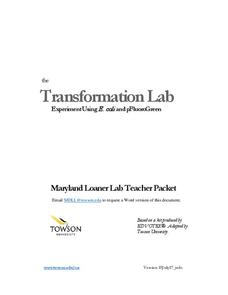Richland County School District One
Incubating Quail Eggs
Students incubate quail eggs. In this biology lesson, students observe the development of the embryo, monitor, turn, weigh the eggs, and observe the hatching of the chicks. They identify the structures within a fertilized egg and their...
Curated OER
Our Chicks Are Hatching!
Students examine the incubation and hatching process for chicks in photographs or with real-life chicks in the classroom. They identify the different stages of the hatching process, and create sculptures of hatching chicks using clay.
Curated OER
Hidden Words
In this wordfind worksheet, students circle the hidden words on the list as it relates to hen eggs and chicks. Students write the message about chicks and the eggs that incubate them until hatching.
Curated OER
Crossword Puzzle: Chicken Incubation
For this chicken incubation crossword worksheet, students read 6 clues pertaining to the hatching and incubation of chicken eggs. Students place their answers in a crossword puzzle.
Curated OER
Science Vocabulary: Incubation of Eggs Alphabetical Order
In this chicken incubation instructional activity, students analyze 24 words that pertain to chickens and eggs. Students put the words in alphabetical order; some words will begin with the same letter.
Curated OER
EGG-STRA, EGG-STRA LEARN ALL ABOUT IT
Students explore how animals produce young by watching age-appropriate videos on the subject. They watch as chicken eggs either hatch or not in an incubator.
American Chemical Society
Chemical Reactions and Engineering Design
Construction leads to habitat loss and local wildlife suffers. Scholars must build a reptile egg incubation device that meets many constraints. Various experiments help them discover the chemical reaction needed to reach the proper...
Curated OER
Hatching chickens
Students recognize the need for gentle care of eggs. In this chicken hatching lesson, students observe the process of incubating eggs for hatching. Students find the materials needed to properly care for the chicks. Students complete a...
Curated OER
Your Body: Bacteria Incubator
Middle schoolers explain the benefits and harm caused by bacteria in the body. In this biology lesson, students observe bacterial growth in the lab. They explain why anti-bacterial soap may not be beneficial for the human body.
Serendip
Is Yeast Alive?
Through two investigations, life science learners determine whether or not yeast is alive. They perform tests for metabolism by providing sugar and observing if gas is produced as a byproduct. They incubate some of the sample for at...
Curated OER
What Kind of Heat?
In this types of heat worksheet, students analyze what type of heat is keeping the eggs warm in the incubators and what type of heat comes from a heat coil.
Curated OER
Incubation and Embryology
Students examine chickens, eggs and hatching eggs through this series of lessons.
Curated OER
Hazards of Defrosted Food
Peas spoilage hot, peas spoilage cold: examine the bacterial growth on newly defrosted peas versus peas that have been defrosted for 24 hours. Using the session one questions in the "Microbes and Food Spoilage" PDF, learners will make...
Curated OER
Your Body: A Bacteria Incubator!
Students use string, a petri dish, water, wipes, and other materials to collect bacteria from their body. In this bacteria lesson plan, students use ingredients to collect bacteria, observe it, predict what will happen over time, and...
Curated OER
Hatching Chickens
Learners consider the concept that much can be learned from the natural world by observation. They observe the incubation and hatching of chicken eggs in the classroom and discuss the needs of living things.
Curated OER
Hatching Chickens
Young scholars observe chickens hatching in a classroom incubation environment In this egg-hatching lesson plan, students make observations of the hatching process and later care for the hatched chickens.
Curated OER
Hatching Chickens
Students observe how chickens hatch. In this life cycles lesson, students read the book Hatching Eggs: A Step by Step Guide and use an incubator to hatch the eggs. Students observe the chicks hatching and take care of the chicks by...
Curated OER
Seed Germination
Students germinate a Mung Bean seed. In this seed lesson students conduct an experiment germinating a Mung Bean. They apply three different treatments to the seeds: dry, moist, and underwater incubation.
Curated OER
The Shape of Things
Sixth graders read and discuss information regarding the shape and attributes of an eggshell. In this shape of things lesson, 6th graders gather relevant information that pertains to the incubation and formation of an eggshell. Students...
Curated OER
DEMONSTRATING AN EPIDEMIC
High schoolers experience a small scale "epidemic," demonstrating the ease with which disease organisms are spread, and enables the student to determine the originator of the "epidemic." They transfer live bacteria by hand contact, then...
Curated OER
Introduction to Aseptic Techniques
Students study bacteria and aseptic microbiology laboratory techniques. They discover how to pour, label, streak, seal and store plates in an incubator and articulate what they have learned via an informational laboratory poster.
.
Curated OER
Capturing Bacteria Growth
Students grow bacteria. In this bacteria growth lesson, students allow bacteris to incubate for 2-3 days. The teacher uses a document camera to show how to remove the bacteria from the plate. Students remove a small sample of bacteria...
Centers for Disease Control and Prevention
Understanding the Epidemiologic Triangle through Infectious Disease
Introduce infectious diseases and the epidemiologic triangle. A helpful resource describes the agent, host, and environment from the three vertices as well as the time factor, which is in the middle. Scholars complete a simple...
Towson University
Transformation Lab
Transform your class' understanding of genes and antibiotic resistance with the Transformation Lab. Junior geneticists create and observe their own resistant strains of E. coli through research, discussion, and experimentation. The...
Other popular searches
- Chicken Incubation
- Incubation of Chicken Eggs
- Egg Incubation
- Chicken Incubation Crossword
- Duck Incubation
- Incubation Observation
- Chick Incubation

























